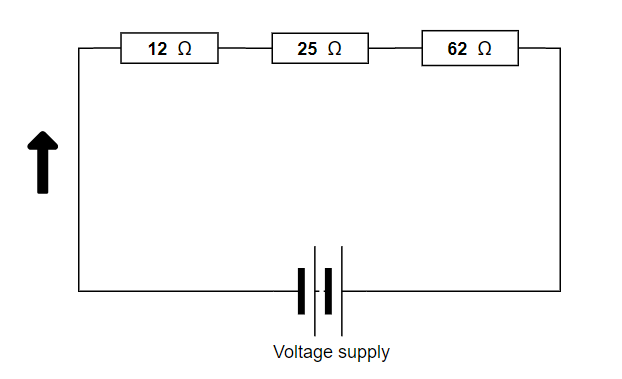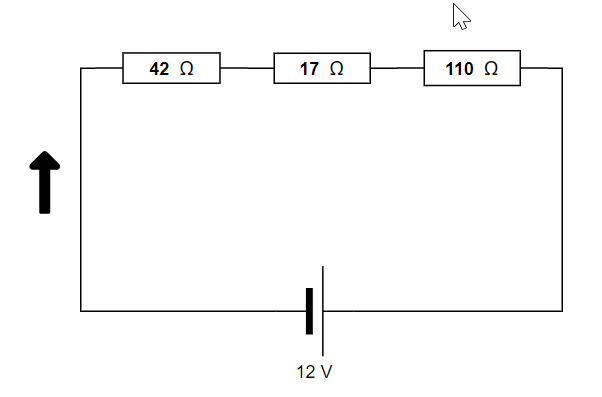
All Solutions
Page 759: Practice Problems
$$
V=I R
$$
Since we know the current, which is 0.032 A, and the total resistance was 750 $Omega$, we know then that resistance on a single resistor is $frac{750 mathrm{Omega}}{3}$ which gives 250 $Omega$ on each resistor.
Since everything in this circuit is connected in series, the same amount of current is going trough each resistor, so the potential difference will be $textbf{equal}$ on each resistor:
$$
V= 250 Omega cdot 0.032 mathrm{~A}
$$
which gives the result of:
$$
V= 8 mathrm{~V}
$$
V_{1=2=3}= 8 mathrm{~V}
$$

$$
I = frac{U}{R} = frac{4.4 mathrm{V}}{12 mathrm{Omega}} = 0.37 mathrm{A}
$$
Now we know the current through all three resistors, so we can calculate the potential difference for the second resistor:
$$
V = I cdot R_2
$$
which gives:
$$
V = 0.37 mathrm{A} cdot 25 mathrm{Omega} = boxed{color{#c34632}9.25 mathrm{V}}
$$
For the $textbf{part b}$ we need to calculate voltage difference on the third resistor, we do the same as in part a:
$$
V = I cdot R_3
$$
$$
V = 0.37 mathrm{A} cdot 62 mathrm{Omega} = boxed{color{#c34632}22.94 mathrm{V}}
$$
(a) 9.25 mathrm{V}
$$
$$
(b) 22.94 mathrm{V}
$$
$$
R=frac{V}{I}
$$

$$
R_{tot} = R_1 + R_2 + R_3
$$
which gives:
$$
R_{tot} = 42 mathrm{Omega} + 17 mathrm{Omega} + 110 mathrm{Omega}
$$
which gives:
$$
R_{tot} = 169 mathrm{Omega}
$$
Using Ohm’s law we calculate the current:
$$
I= frac{V}{R} = frac{12 mathrm{V}}{169 mathrm{Omega}} = boxed{color{#c34632}0.071 mathrm{A}}
$$
For the $textbf{part b}$ we calculate potential difference across each resistor, also using Ohm’s law:
$$
V_1 = I cdot R_1 = 0.071 mathrm{A} cdot 42 mathrm{Omega} = 2.98 mathrm{V}
$$
$$
V_2 = I cdot R_2 = 0.071 mathrm{A} cdot 17 mathrm{Omega} = 1.21 mathrm{V}
$$
$$
V_3 = I cdot R_3 = 0.071 mathrm{A} cdot 110 mathrm{Omega} = 7.81 mathrm{V}
$$
(a) 0.071 mathrm{A}
$$
$$
(b) V_1=2.98 mathrm{V}, V_2=1.21 mathrm{V}, V_3=7.81 mathrm{V}
$$
Haven't found what you were looking for?
Search for samples, answers to your questions and flashcards

